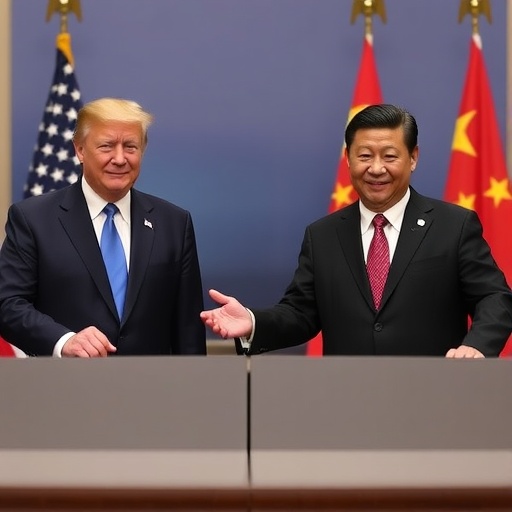US-China Trade Tensions Ease as Trump and Xi Gear Up for High-Stakes Summit in Kuala Lumpur
In a surprising turn amid years of economic friction, US-China trade tensions appear to be cooling just days before President Donald Trump and Chinese President Xi Jinping are set to convene at the ASEAN summit in Kuala Lumpur. This pivotal meeting, scheduled for next week, signals a potential thaw in bilateral relations, with Trump pushing for innovative economic frameworks that could reshape global supply chains and foster deeper regional cooperation.
The easing of tensions comes after a series of backchannel communications and preliminary agreements that have halted the escalation of tariffs on key goods like semiconductors and agricultural products. Sources close to the White House indicate that Trump views this summit as a golden opportunity to reset the US-China trade dynamic, emphasizing fair competition and mutual benefits in the Asia-Pacific region.
Analysts are buzzing with optimism, noting that recent data from the U.S. Trade Representative shows a 15% drop in unresolved trade disputes since last quarter, a stark contrast to the aggressive posturing that defined 2018-2020. As the world watches, this encounter between Trump and Xi Jinping could mark a new chapter in US-China relations, potentially averting a broader economic slowdown.
Backchannel Breakthroughs Defuse Tariff Threats
The recent de-escalation in US-China trade spats hasn’t happened overnight. Behind the scenes, diplomats from both sides have been working tirelessly to iron out differences that have plagued bilateral commerce for years. In a notable development last month, the U.S. agreed to suspend planned tariffs on $50 billion worth of Chinese electronics, in exchange for Beijing’s commitments to increase purchases of American soybeans and energy exports.
According to a report from the Peterson Institute for International Economics, these concessions could boost U.S. agricultural exports by up to 20% in the coming year, providing much-needed relief to Midwest farmers who have borne the brunt of previous trade wars. “This is a pragmatic step forward,” said trade expert Dr. Elena Ramirez in an interview with Reuters. “Both Trump and Xi Jinping recognize that prolonged tensions hurt their domestic economies equally.”
Historical context underscores the significance of this shift. The US-China trade war, ignited in 2018 under Trump’s first term, led to over $300 billion in tariffs and disrupted global markets. Yet, with inflation pressures mounting globally—U.S. consumer prices rose 3.2% year-over-year in recent figures—the urgency for dialogue has intensified. ASEAN’s neutral platform in Kuala Lumpur provides the perfect stage for these discussions, away from the glare of Washington or Beijing.
Key stakeholders, including tech giants like Apple and Huawei, are closely monitoring the situation. A successful outcome could stabilize supply chains, reducing costs for consumers worldwide. As one industry insider put it, “The end of tariff brinkmanship means innovation can flourish without the shadow of economic coercion.”
Trump’s Bold Vision for Economic Overhaul at ASEAN
President Trump’s agenda for the ASEAN summit is nothing short of ambitious. He arrives in Kuala Lumpur with a blueprint for new economic frameworks that prioritize American interests while inviting China to the table on equal footing. Central to his pitch is the expansion of bilateral investment treaties that would open Chinese markets further to U.S. services and intellectual property protections.
In a recent speech at the White House, Trump outlined his goals: “We’re not here to fight; we’re here to build. With Xi Jinping, we’ll forge deals that make America strong and keep the world prosperous.” This rhetoric marks a departure from his earlier “America First” hardline, now tempered by the realities of a post-pandemic economy where U.S.-China interdependence is undeniable.
Statistics paint a compelling picture of the stakes involved. The US-China trade volume reached $690 billion in 2023, making China the U.S.’s largest trading partner. However, imbalances persist—U.S. exports to China lag behind imports by $200 billion annually. Trump’s strategy includes leveraging ASEAN’s growing economic bloc, which boasts a combined GDP of $3.6 trillion, to encourage multilateral pacts that dilute China’s dominance in regional trade.
Experts like those at the Brookings Institution highlight Trump’s focus on digital trade as a game-changer. Proposals include standardized data flow regulations that could benefit U.S. firms like Google and Amazon, while addressing Xi Jinping’s concerns over cybersecurity. “ASEAN’s role is crucial here,” noted Brookings fellow Dr. Marcus Hale. “It acts as a bridge, ensuring the summit doesn’t devolve into bilateral finger-pointing.”
Preparatory meetings with ASEAN leaders, including Malaysian Prime Minister Anwar Ibrahim, have already yielded side agreements on infrastructure projects, such as high-speed rail links funded jointly by U.S. and Chinese capital. These initiatives underscore Trump’s vision of cooperative competition, where US-China trade evolves from rivalry to partnership.
Xi Jinping’s Calculated Approach to Regional Diplomacy
On the other side of the Pacific, Xi Jinping approaches the summit with a blend of caution and confidence. Beijing’s state media has framed the upcoming talks as an extension of China’s “win-win” foreign policy, emphasizing harmony in US-China relations without compromising core interests like technological sovereignty.
Xi’s delegation, including high-level officials from the Ministry of Commerce, is prepared to discuss concessions on market access for U.S. financial services, potentially unlocking $100 billion in new investments. A Xinhua report quoted a spokesperson: “President Xi Jinping believes in dialogue over division. The ASEAN platform allows for constructive engagement on trade and beyond.”
China’s economic playbook has evolved significantly. With its Belt and Road Initiative now spanning 150 countries, Xi Jinping seeks to position China as a stabilizing force in ASEAN. Recent data from the World Bank shows Chinese investments in Southeast Asia surging 25% to $15 billion last year, focusing on green energy and digital infrastructure. This gives Xi leverage in negotiations, as ASEAN nations increasingly view China as an indispensable partner.
Yet, challenges remain. U.S. accusations of intellectual property theft and forced technology transfers continue to irk Beijing. Xi’s response, as articulated in a recent op-ed in the People’s Daily, calls for “mutual respect” in US-China trade. Analysts speculate that Xi might offer olive branches, such as increased imports of U.S. liquefied natural gas, to counter domestic slowdowns—China’s GDP growth dipped to 4.7% in the latest quarter.
The personal dynamic between Trump and Xi adds intrigue. Their previous summits, from Mar-a-Lago in 2017 to Osaka in 2019, produced mixed results but built a rapport. Insiders predict that Xi will use the Kuala Lumpur setting to highlight China’s commitment to multilateralism, subtly pressuring Trump to align with ASEAN’s inclusive vision.
Stakeholder Reactions and Market Ripples
The anticipation surrounding the Trump-Xi meeting has sent ripples through global markets. Wall Street indices climbed 2.5% in the past week, with semiconductor stocks like Nvidia leading the charge on hopes of eased US-China trade restrictions. “Investors are pricing in a detente,” said JPMorgan analyst Sarah Kline. “Any positive signals from Kuala Lumpur could add trillions to global trade value.”
Business leaders are vocal in their support. The U.S. Chamber of Commerce issued a statement urging both leaders to prioritize supply chain resilience, citing disruptions from the COVID-19 era that cost the global economy $2.5 trillion. In China, the China Council for the Promotion of International Trade echoed similar sentiments, calling for “a new era of US-China economic synergy.”
Environmental groups, however, express mixed views. While trade normalization could boost green tech exchanges—China leads in solar panel production with 80% global market share—concerns linger over lax enforcement of labor and ecological standards. A coalition of NGOs plans to protest at the summit’s fringes, demanding enforceable sustainability clauses in any new frameworks.
On the ground in ASEAN, reactions vary. Vietnamese manufacturers, who benefited from trade war diversions with $20 billion in new U.S. orders, welcome the cooling but fear a full US-China rapprochement could redirect flows. Malaysian officials, hosting the event, project optimism: “This summit will catalyze growth for all,” said Trade Minister Zafrul Aziz.
Academic perspectives add depth. A study from the Asian Development Bank forecasts that successful US-China trade reforms could lift ASEAN GDP by 1.5% annually through 2030, emphasizing the summit’s regional stakes.
Charting the Path Forward: Opportunities and Uncertainties
As the Trump-Xi summit unfolds in Kuala Lumpur, the world holds its breath for breakthroughs that could redefine US-China trade for decades. Potential outcomes include a landmark agreement on digital economy rules, paving the way for seamless cross-border e-commerce worth $1 trillion by 2025. Regional cooperation might extend to joint ventures in AI and renewable energy, aligning with ASEAN’s sustainability goals.
Yet, uncertainties abound. Geopolitical flashpoints, like tensions in the South China Sea, could derail progress. Trump’s domestic politics—midterm pressures demand quick wins—may push for aggressive concessions, while Xi Jinping navigates internal calls for economic nationalism.
Looking ahead, experts predict a phased implementation of any deals, starting with tariff reductions and culminating in a comprehensive US-China-ASEAN trade pact by 2025. The International Monetary Fund warns that failure to capitalize on this momentum could shave 0.8% off global growth. Optimists, however, see Kuala Lumpur as a turning point: a summit where adversaries become architects of shared prosperity.
In the broader landscape, this easing of US-China tensions reinforces ASEAN’s rising clout as a diplomatic hub. For businesses and consumers alike, the implications are profound—from lower prices on everyday goods to innovation booms in tech sectors. As Trump and Xi Jinping shake hands, the message is clear: collaboration trumps confrontation in an interconnected world.








